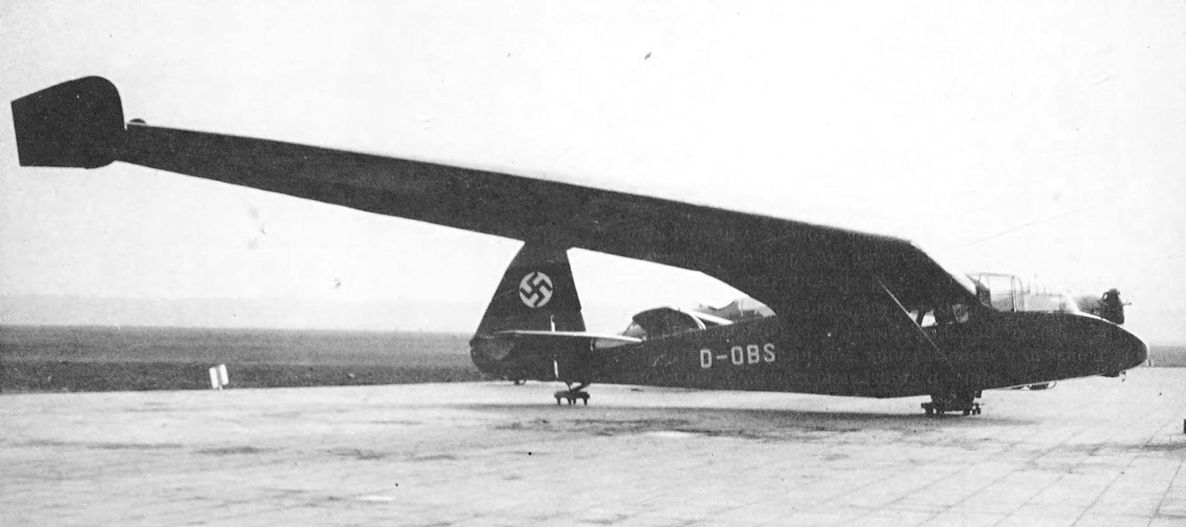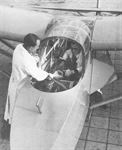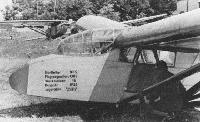
M.Simons The World's Vintage Sailplanes 1908-45
THE OBS
As its name suggested, the Obs was a flying scientific observatory which could carry an observer and a hefty load of instruments or, if necessary, two passengers in addition to the pilot. It was designed by Lippisch in 1931-2. The requirement was for a research vehicle for the RRG. The Obs was too large to be built in the RRG’s own workshops on the Wasserkuppe so the work was contracted out to Alexander Schleicher’s factory in Poppenhausen.
The great wing was of wooden, single-spar construction, complicated by sweepback of the outer panels, together with a slight ‘gull’ dihedral form and endplates at the tips. Lippisch, always thinking of stability and deeply immersed in research into tailless aircraft, used an aerofoil with a reflex camber line to give a stationary centre of pressure and the tip ‘winglets', as on the Storch series, were there to reduce vortex drag and aid the rudder in controlling the huge wing around the yawing axis. The ailerons were complex. To prevent binding at the hinges as the wing flexed under load, they were divided into three sections, with slots to improve their effectiveness, and differentially geared. The innermost pair were made also to act as camber flaps when required. It was anticipated that lateral control would be difficult with such a large span. Spoilers or airbrakes were fitted just inboard of the ‘gull’ bend, but these are not shown on any extant drawing and their exact design is unknown. Large ‘N’ struts supported the wing. The fuselage was a welded steel tube box frame covered with fabric. Diagonal bracing aft of the wing was by tensioned wires. The cockpit, fully enclosed with a built-up transparent canopy of numerous celluloid panels in a wooden frame, was located ahead of the wing. The observer, provided with large rectangular windows and an access door, sat in his spacious cabin with a writing table, under the wing. For landings and take-off, two large wheels were fitted close to the centre of gravity when the glider was loaded. For ground handling, small trolleys with castoring wheels were used, one under the main wheels, another under the tailskid. An interesting feature was that the pendulum elevators were strut-braced, the strut attachment point being also a hinge. This was later modified.
To manage the large control forces, the pilot had an airliner-type control wheel instead of the simple stick, with reduction geared drive to the massive ailerons.
The Obs appeared at the Wasserkuppe meeting in 1932 and made a short flight towed by a Flamingo power plane which could not manage the task and stalled into the trees just after getting airborne. To launch the Obs by bungee required a crew of twenty men with a double bungee rope. The weight, without crew, was 390 kg, and the allowance for crew and scientific instruments of 250 kg brought the total to 640 kg.
From 1933 on , the Obs was stationed at Darmstadt and was extensively used for research and also, probably, for instruction in blind flying. In 1935 it was used by Heini Dittmar to set a new two-seat gain-of-height record of 2800 metres, though this was not formally recognised. What became of the Obs is not known. Presumably it remained in service and must have been destroyed in one way or another during the last few weeks of the war. After the crash of the Austria, it was the largest sailplane in the world.
Technical data:
Obs: Span, 26.00 m. Wing area, 38 sq m. Aspect ratio. 17.80. Empty weight, 390 kg. Flying weight. 640 kg. Wing loading. 16.8 kg/sq m. Aerofoil. Lippisch designed with reflex camber.
- M.Simons The World's Vintage Sailplanes 1908-45
Фотографии
-
GL / M.Simons - The World's Vintage Sailplanes 1908-45 /Kookaburra/
Регистрационный номер: D-OBS [4] The Obs at Munich Airport on the occasion of a meteorological a soaring conference in 1934. In this photograph the Obs has a tailplane with hinged elevator. The original description and drawings published in 1932 show an all-moving tailplane. Evidently there were modifications after test flying. According to tradition, it was on this occasion that Adolf Hitler saw the huge sailplane and conceived the idea of using gliders to earn soldiers into battle.
-
GL / M.Simons - The World's Vintage Sailplanes 1908-45 /Kookaburra/
Регистрационный номер: D-OBS [4] The Obs being prepared for a research flight, using special instruments. The original canopy was replaced with a metal-framed type fairly early in the sailplane’s career.
-
Air Enthusiast 1972-03 / ??? - The Rise and Demise of a Weapon (1)
Регистрационный номер: D-OBS [4] The progenitor of the transport glider, the OBS meteorological observation glider.
-
Air Enthusiast 1972-03 / ??? - The Rise and Demise of a Weapon (1)
Регистрационный номер: D-OBS [4]
- Фотографии




